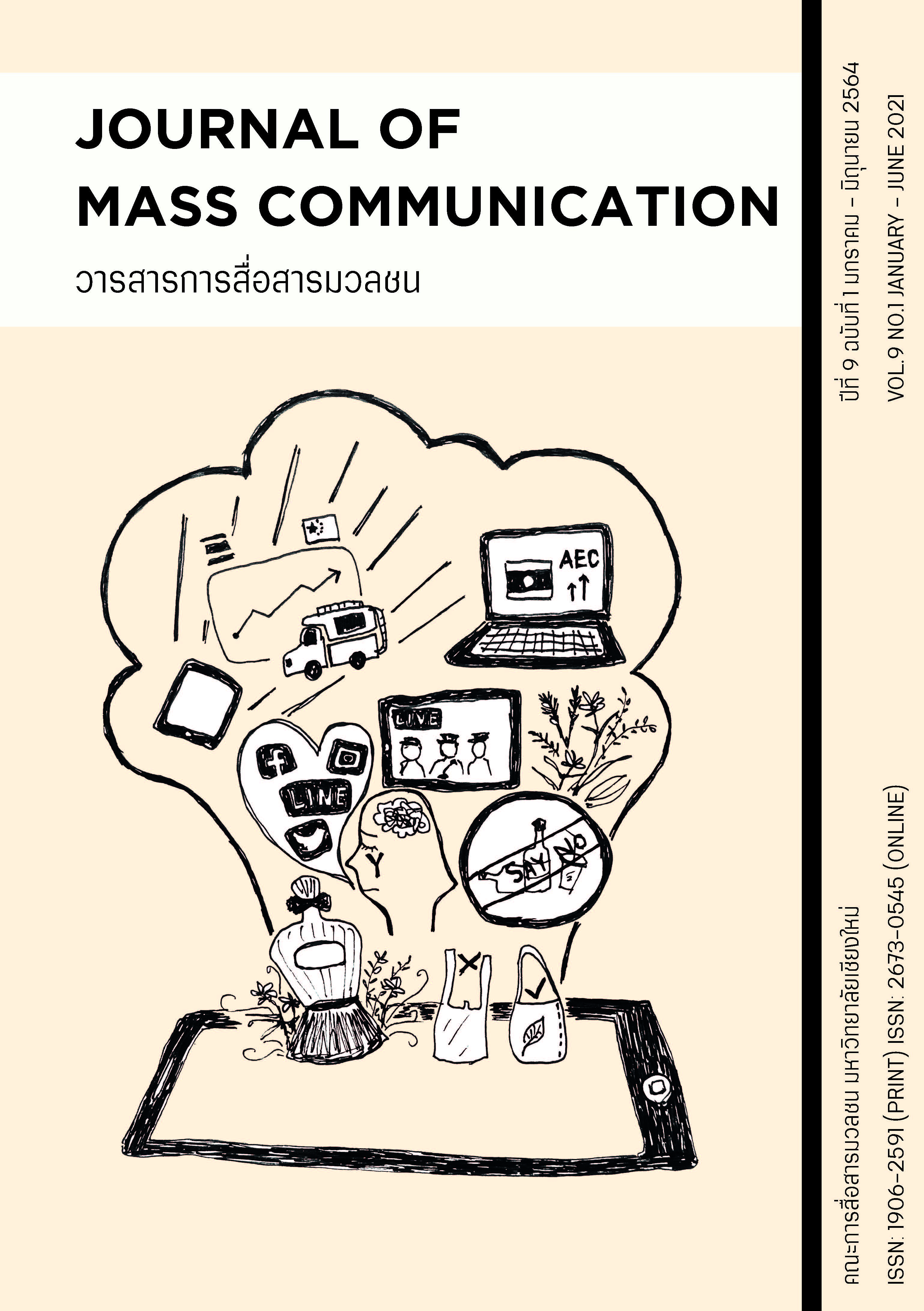MEDIA EXPOSURE, KNOWLEDGE, ATTITUDES AND THE BEHAVIOUR OF PLASTIC PACKAGING REDUCTION IN BANGKOK
Main Article Content
Abstract
This research aimed to encourage Thais’ awareness. 1. To analyse regional demographics such as media exposure, knowledge, attitudes and the behaviour of plastic packaging reduction in Bangkok 2. To study the differences between regional demographics and media exposure about plastic packaging reduction of Bangkokian. 3. To study the relationship between media exposure and knowledge about plastic packaging reduction of Bangkokian. 4. To study the relationship between knowledge and attitudes about plastic packaging reduction of Bangkokian. 5. To study the relationship between attitudes and the behavior of plastic packaging reduction among the 2019 population in Bangkok. This research is quantitative research by collecting data on all population at approximately 400 peoples (aged 18-60 years) who live or work in Bangkok.
The result of this research showed that 1. The sample survey understood the topic media exposure of plastic packaging reduction by overall moderate level via all social media platforms. The most popular online platform is Facebook, while the most of popular offline platform is store advertising campaign. 2. There is a negative correlation about the topic media exposure of plastic packaging knowledge via online platform. 3. There is no relation about the topic media exposure of plastic packaging reduction knowledge via offline platform. 4. The knowledge has a positive correlation about the attitudes of plastic packaging reduction. This variable is fair correlated. 5. The attitude has a positive correlation about the behaviour of plastic packaging reduction. This variable is fair correlated.
Article Details

This work is licensed under a Creative Commons Attribution-NonCommercial-NoDerivatives 4.0 International License.
ลิขสิทธ์ที่ผู้เขียนบทความต้องยอมรับ
References
กิติมา สุรสนธิ. (2533). ความรู้ทางการสื่อสาร. กรุงเทพฯ : คณะวารสารศาสตร์และ
สื่อสารมวลชน มหาวิทยาลัยธรรมศาสตร์
กาญจนา แก้วเทพ. (2541). การวิเคราะห์สื่อ: แนวคิดและเทคนิค. กรุงเทพฯ : อินฟินิตี้เพรส.
ปรมะ สตะเวทิน. (2533). การสื่อสารมวลชน: กระบวนการและทฤษฎี. กรุงเทพฯ : จุฬาลงกรณ์มหาวิทยาลัย.
ปรมะ สตะเวทิน. (2538). หลักนิเทศศาสตร์. กรุงเทพฯ : ห้างหุ้นส่วนจำกัดภาพพิมพ์.
ปรมะ สตะเวทิน. (2539). การสื่อสารมวลชน: กระบวนการและทฤษฎี. กรุงเทพฯ : จุฬาลงกรณมหาวิทยาลัย.
ยุบล เบ็ญจรงค์กิจ. (2534). การวิเคราะห์ผู้รับสาร. กรุงเทพฯ : จุฬาลงกรณ์มหาวิทยาลัย.
ศิริวรรณ เสรีรัตน์. (2542). การวิจัยตลาด : ฉบับมาตรฐาน. กรุงเทพฯ : บริษัท ธรรมสาร จํากัด.
สุรพงษ์ โสธนะเสถียร. (2533). การสื่อสารกับสังคม. กรุงเทพฯ : โรงพิมพ์จุฬาลงกรณ์มหาวิทยาลัย.
อรวรรณ ปิลันธน์โอวาท.(2542). การสื่อสารเพ่ือการโน้มน้าวใจ. กรุงเทพฯ :
โรงพิมพ์จุฬาลงกรณ์มหาวิทยาลัย.
Todd Hunt and Brent d. Ruben. (1993). Mass communication: Producers and consumers. New York : HarperCollins.
บทความในวารสาร
ฐาปะนะ วงษ์สาธิตศาสตร์. (2552). การเปิดรับสื่ออินเทอร์เน็ต การใช้และทัศนคติต่อการสื่อสารผ่าน
เครือข่ายอินเทอร์เน็ตเพื่อการเรียนรู้ของนักศึกษาและอาจารย์มหาวิทยาลัยรามคำแหง.
วารสารวิจัยรามคำแหง ฉบับมนุษยศาสตร์และสังคมศาสตร์, ปีที่ 12 (ฉบับที่ 1)
วิทยานิพนธ์และสารนิพนธ์
ไณยณันทร์ นิสสัยสุข. (2559). ค่านิยม ทัศนคติ และพฤติกรรมการซ้ือผลิตภัณฑ์ที่่เป็นมิตรกับสิ่งแวดล้อม. (วิทยานิพนธ์ปริญญามหาบัณฑิต). มหาวิทยาลัยบูรพา, คณะมนุษยศาสตร์และสังคมศาสตร์.
มนชิดา ทองก้อน. (2546). เจตคติ การคล้อยตามกลุ่มอ้างอิงกับความตั้งใจในการใช้ผลิตภัณฑ์
เพื่อสิ่งแวดล้อมของนักศึกษามหาวิทยาลัยหัวเฉียวเฉลิมพระเกียรติ. (วิทยานิพนธ์ศึกษา
ศาสตรมหาบัณฑิต). มหาวิทยาลัยมหิดล, สาขาวิชาสิ่งแวดล้อมศึกษา.
มารียัม เจ๊ะเต๊ะ. (2556). ปัจจัยที่มีความสัมพันธ์กับการอนุรักษ์สิ่งแวดล้อมในโรงเรียนของนักเรียนชั้น
มัธยมศึกษาตอนต้น: กรณีศึกษา โรงเรียนธรรมวิทยามูลนิธิ อำเภอเมือง จังหวัดยะลา. (วิทยานิพนธ์
ปริญญามหาบัณฑิต). สถาบันบัณฑิตพัฒนบริหารศาสตร์, คณะพัฒนาสังคมและสิ่งแวดล้อม.
เอกสารอิเล็กทรอนิกส์
กรุงเทพธุรกิจ. (2562). ไทย : หลุมขยะพลาสติกอันดับ 3 ของอาเซียน. สืบค้น 19 กุมภาพันธ์ 2563, จาก
https://www.bangkokbiznews.com/news/detail/838523
กรุงเทพธุรกิจ. (2563). เปิดอินไซต์คนไทย เสพคอนเทนต์ออนไลน์ ทั้งอ่าน ทั้งดู. สืบค้น 25 มีนาคม 2563, จาก https://www.bangkokbiznews.com/news/detail/867019
กระทรวงทรัพยากรธรรมชาติและสิ่งแวดล้อม. (2562). Roadmap การจัดการขยะพลาสติก พ.ศ.2561-2573. สืบค้น 19 กุมภาพันธ์ 2563, จาก http://www.pcd.go.th/Info_serv/File/Plastic%20Roadmap.pdf
กองสารนิเทศ สป.มท. (2562). มท. ขับเคลื่อน ลด ละ เลิก “การใช้ขยะพลาสติก” อย่างต่อเนื่องตามนโยบายรัฐบาล. สืบค้น 14 กุมภาพันธ์ 2563, จาก https://gnews.apps.go.th/news?news=42847
มติชนรายสัปดาห์. (2562). ลดใช้ถุงพลาสติก ลดโลกร้อน มาทำให้โลกนี้น่าอยู่กันเถอะ. สืบค้น 19 กุมภาพันธ์ 2563, จาก https://www.matichonweekly.com/publicize/article_230964
สถาบันบัณฑิตพัฒนบริหารศาสตร์ (นิด้า). (2563). งดใช้ถุงพลาสติก. สืบค้น 19 กุมภาพันธ์ 2563, จาก
http://nidapoll.nida.ac.th/index.php?op=polls-detail&id=703
BBCNews. (2563). งดใช้ถุงพลาสติก : จะเกิดอะไรขึ้นหลังคนไทยเลิกใช้ถุงพลาสติก. สืบค้น 15 กุมภาพันธ์ 2563, จาก https://www.bbc.com/thai/thailand-50963578
Businesstoday. (2561). สรุปผลการสำรวจพฤติกรรมและแนวโน้มการบริโภคสื่อของไทย. สืบค้น 19 กุมภาพันธ์ 2563, จาก https://businesstoday.co/technology/06/12/2019/สรุปผลการสำรวจพฤติกรรม
ETDA. (2561). ETDA เปิดพฤติกรรมผู้ใช้อินเทอร์เน็ตปี 61 คนไทยใช้เน็ตเพิ่ม 10 ชั่วโมง 5 นาทีต่อวัน. สืบค้น 15 กุมภาพันธ์ 2563, จาก https://www.etda.or.th/content/etda-reveals-thailand-internet-user-profile-2018.html
Greenpeace. (2563). ‘งดแจกถุงหูหิ้วโดยสมัครใจ’ มันช่วยลดมลพิษพลาสติกได้จริงหรือ!?!. สืบค้น 18 กุมภาพันธ์ 2563, จาก https://www.greenpeace.org/thailand/story/11099/plastic-no-single-use-plastic-bag/
Heroprint. (2562). ข้อดี - ข้อเสีย ของป้ายโฆษณา. สืบค้น 24 เมษายน 2563, จาก https://www.hero-print.com/content/4323/ข้อดี-ข้อเสีย-ของป้ายโฆษณา
Positioning. (2560). Facebook เผยโฆษณาบนมือถือ คนดูแค่ 5.7 วินาที ดูถี่ขึ้นแต่ใช้เวลาน้อยลง. สืบค้น 15 กุมภาพันธ์ 2563, จาก https://positioningmag.com/1128764
UNประเทศไทย. (2558). เป้าหมาย. สืบค้น 4 มิถุนายน 2563, จาก https://www.un.or.th/globalgoals/th/the-goals/

